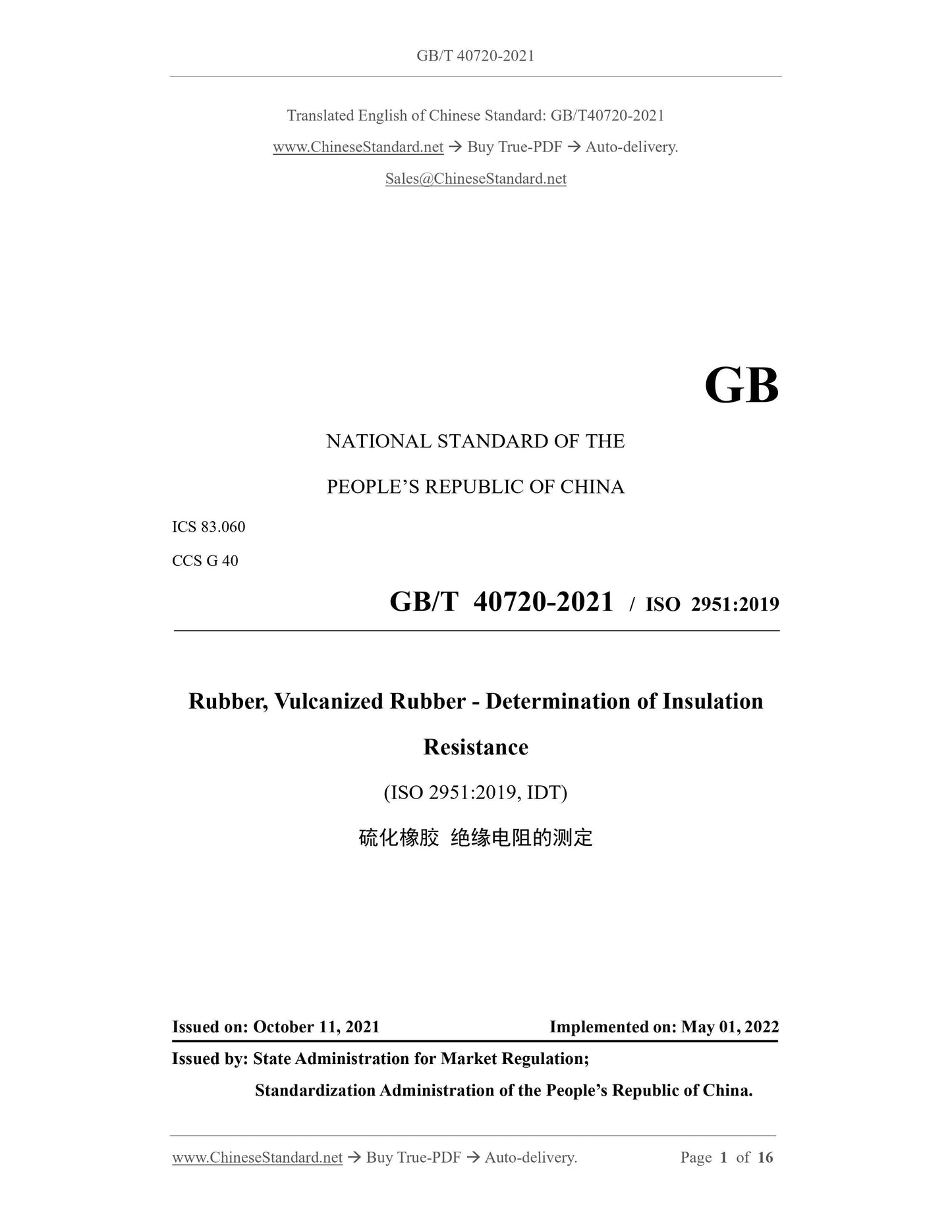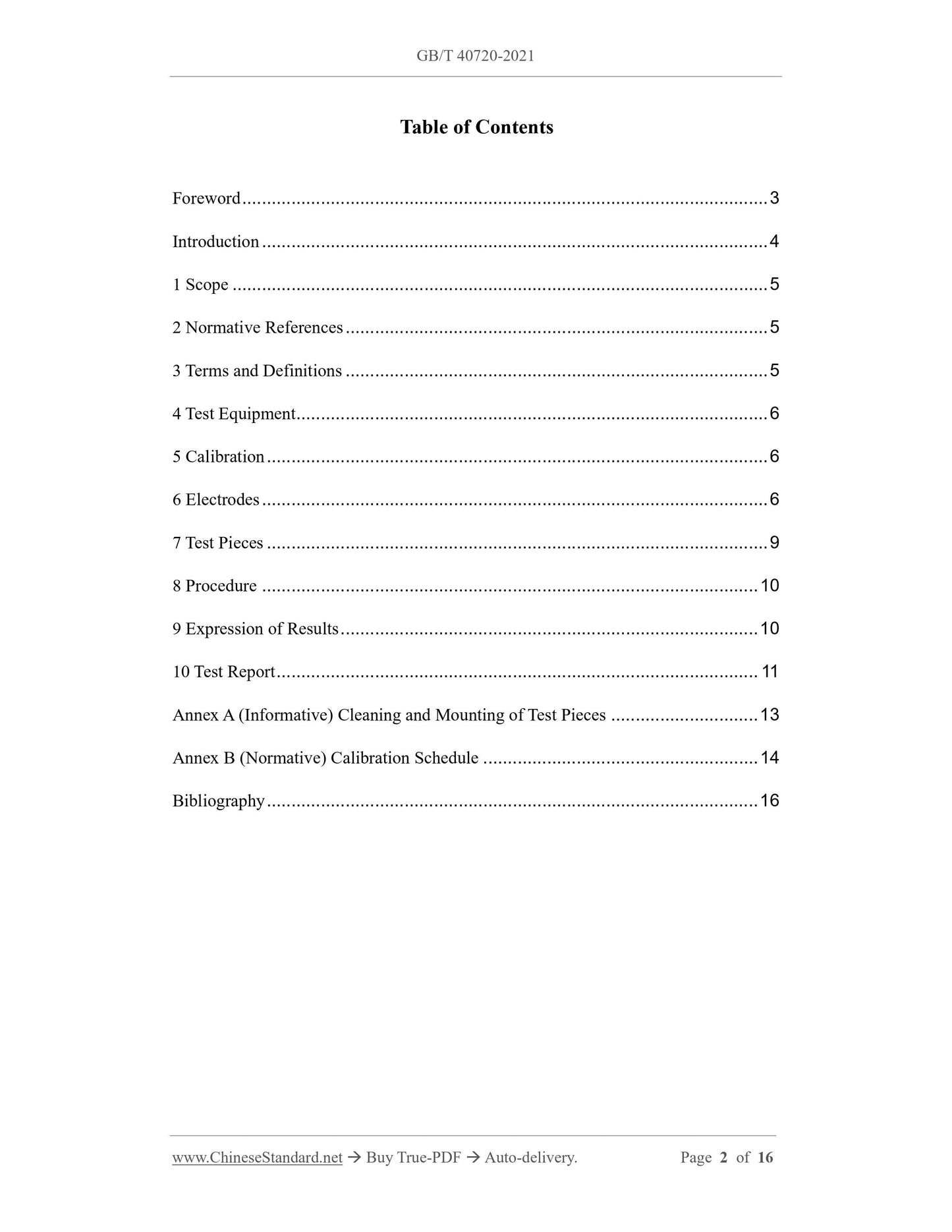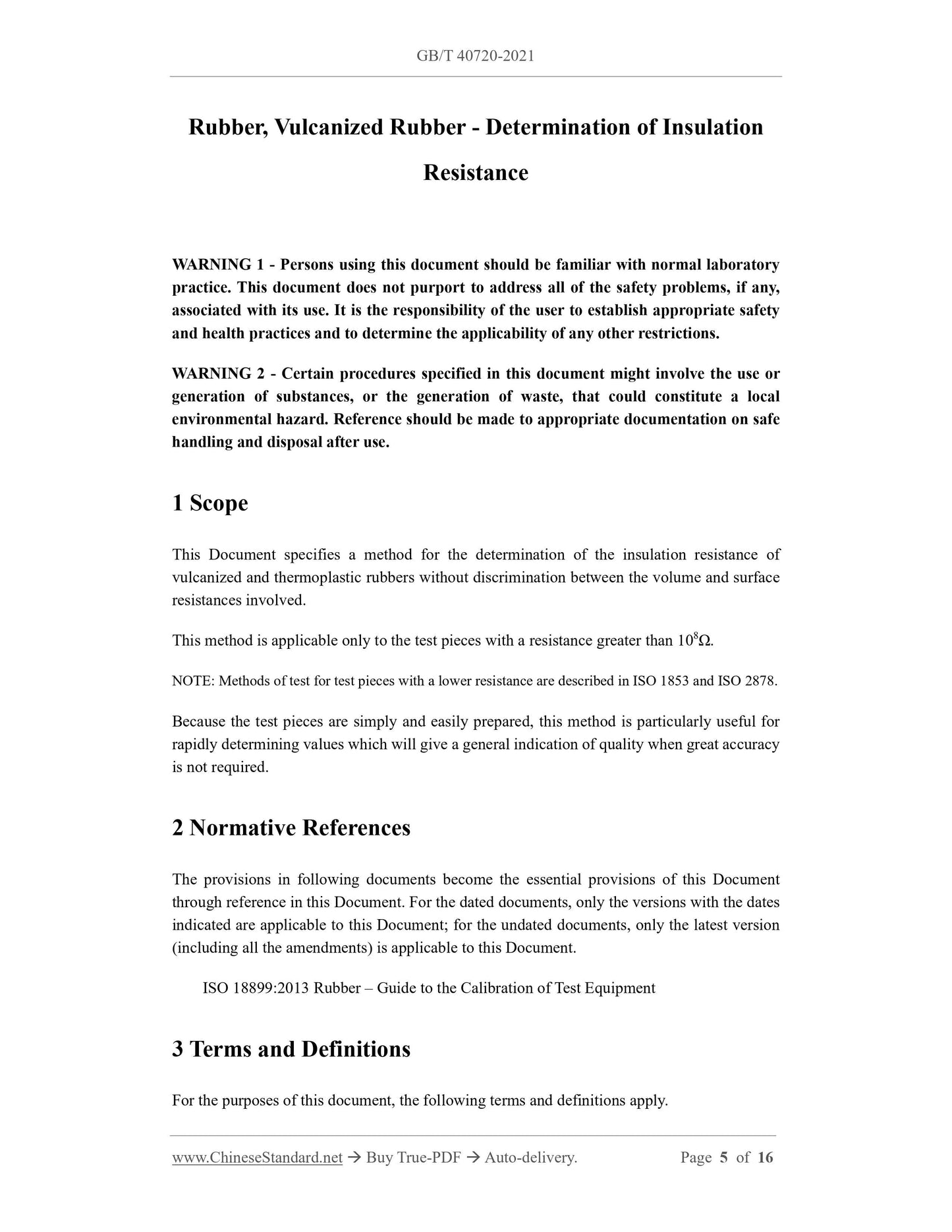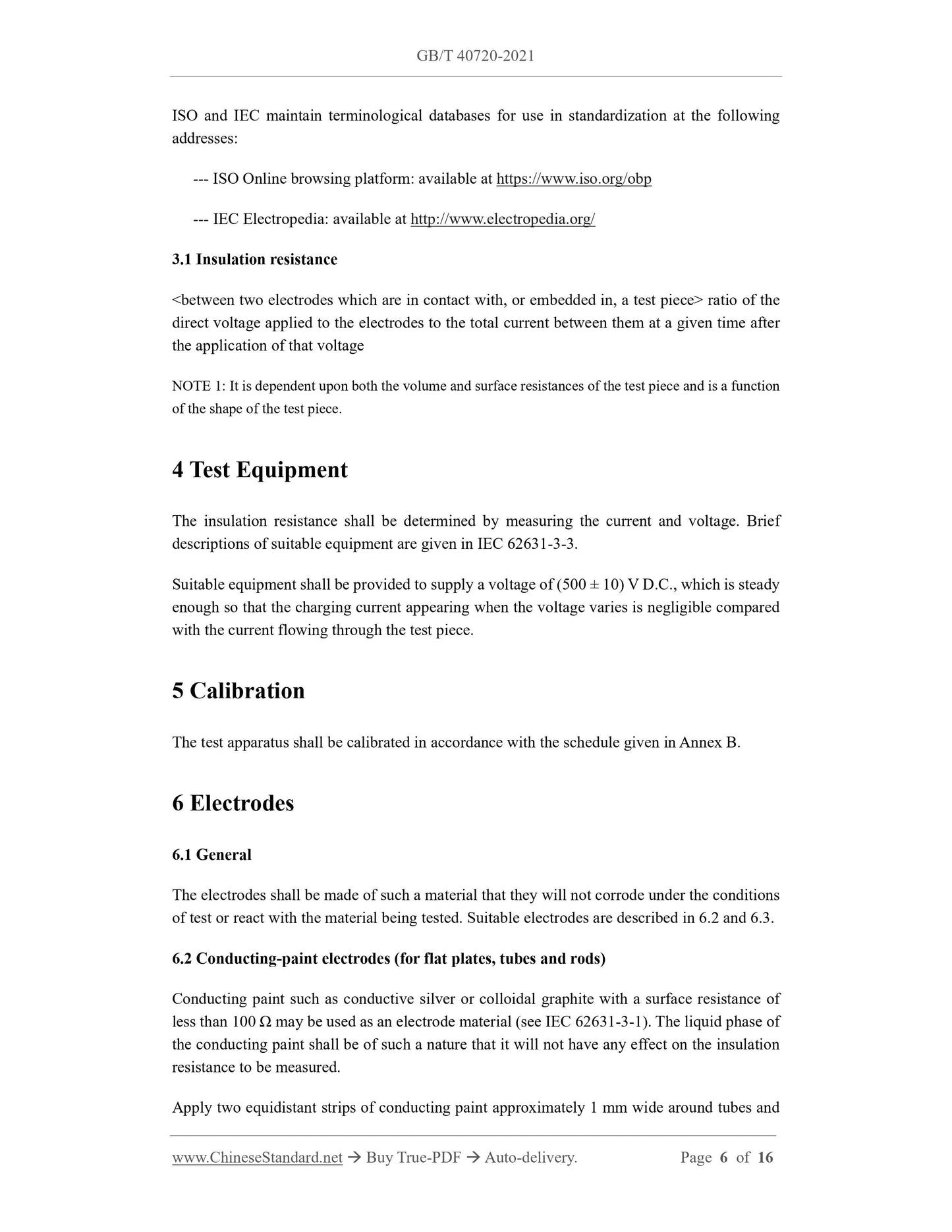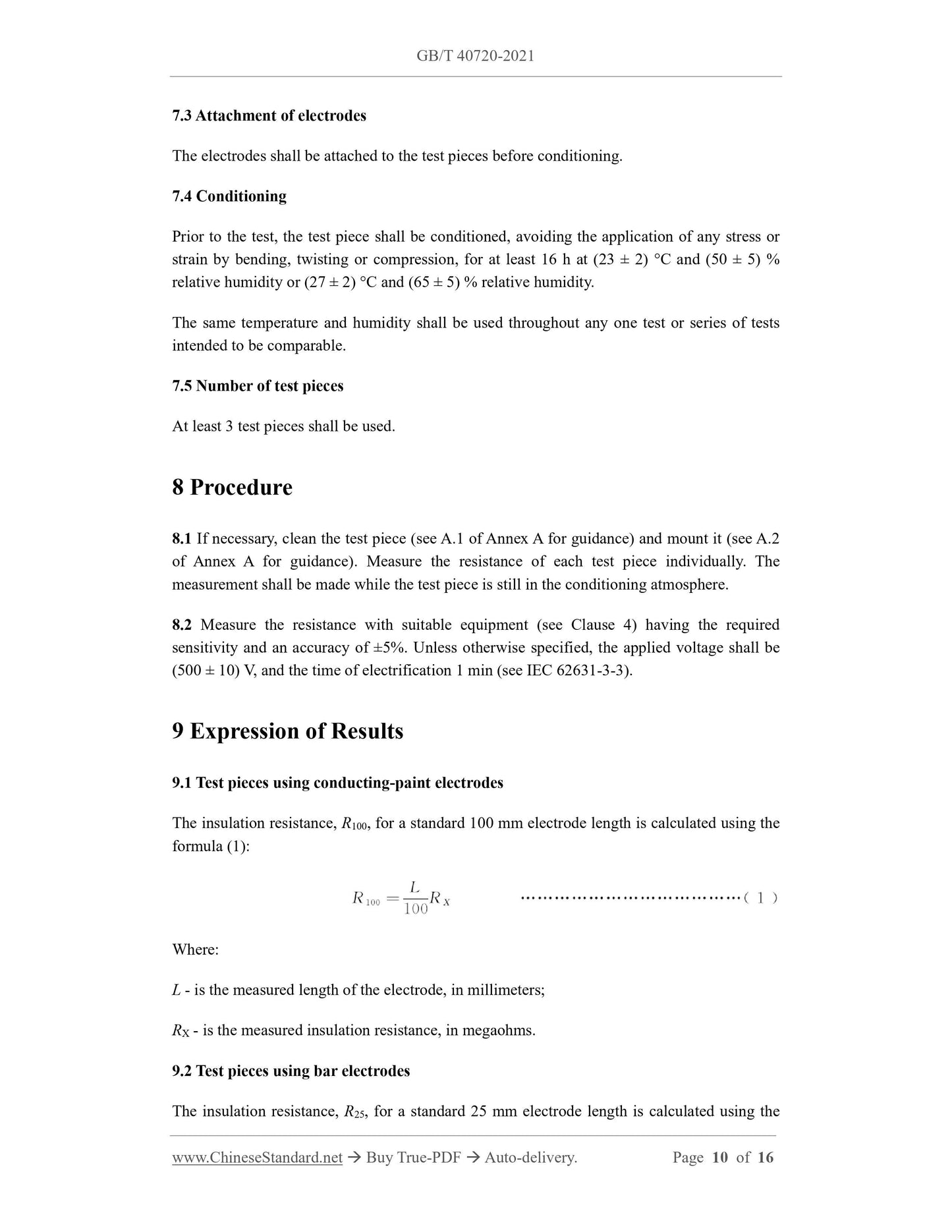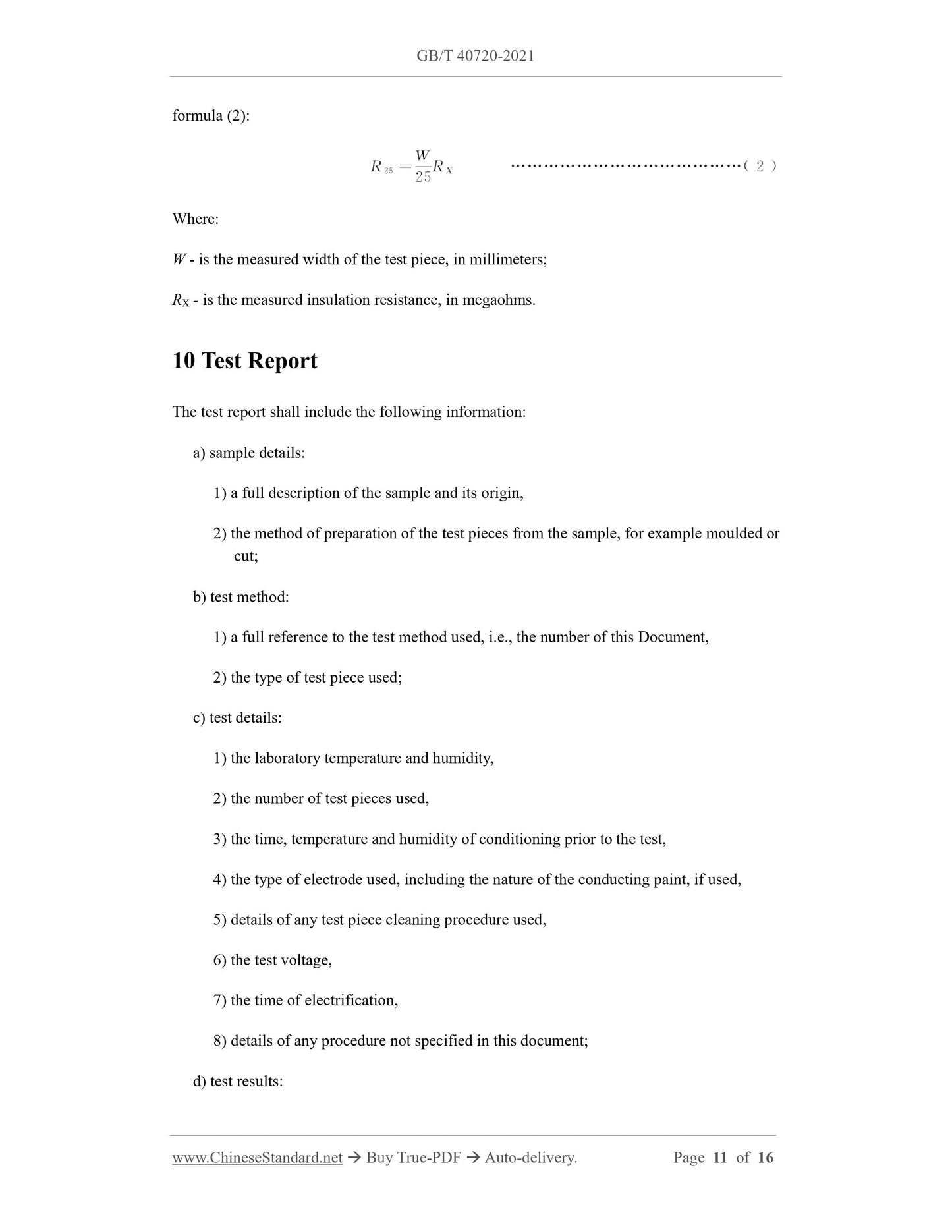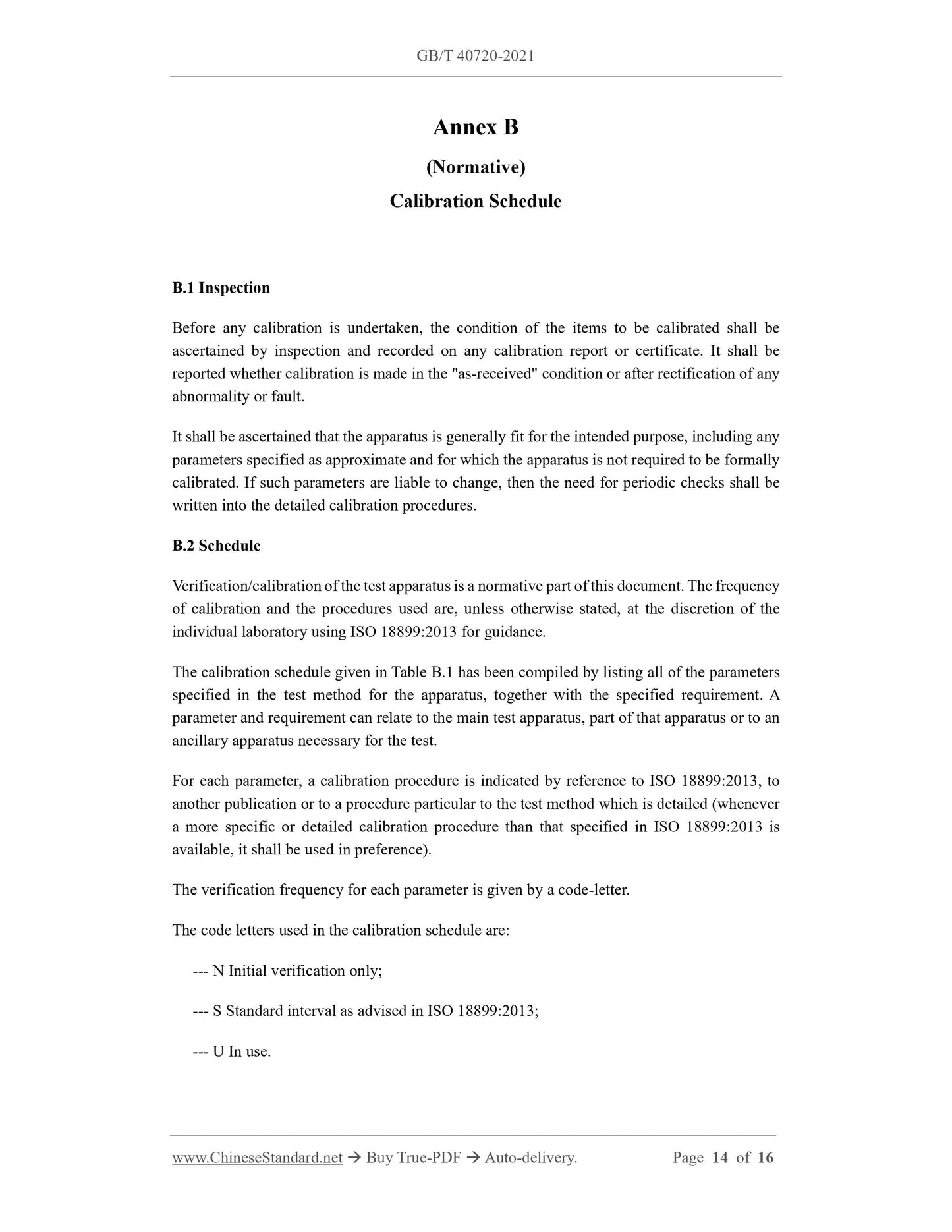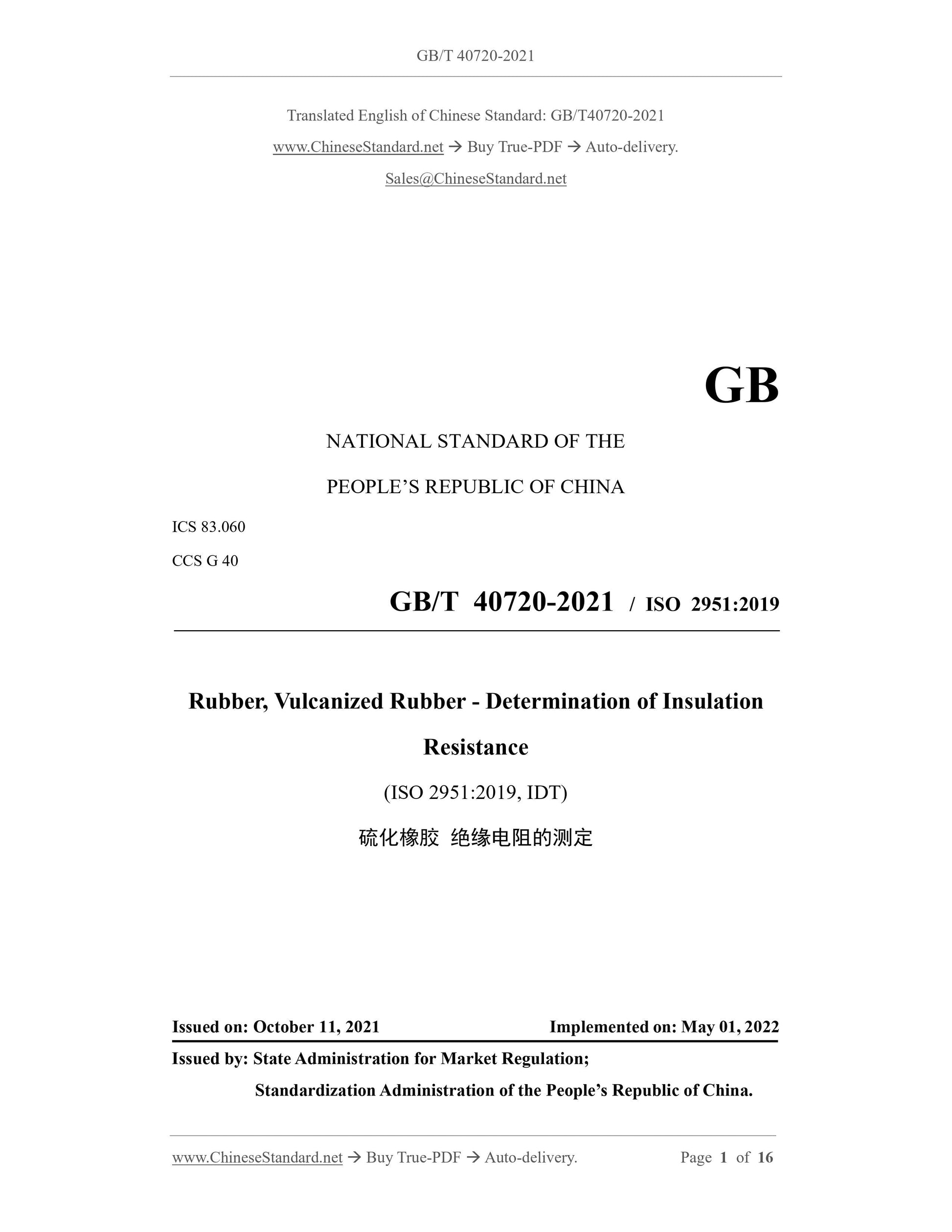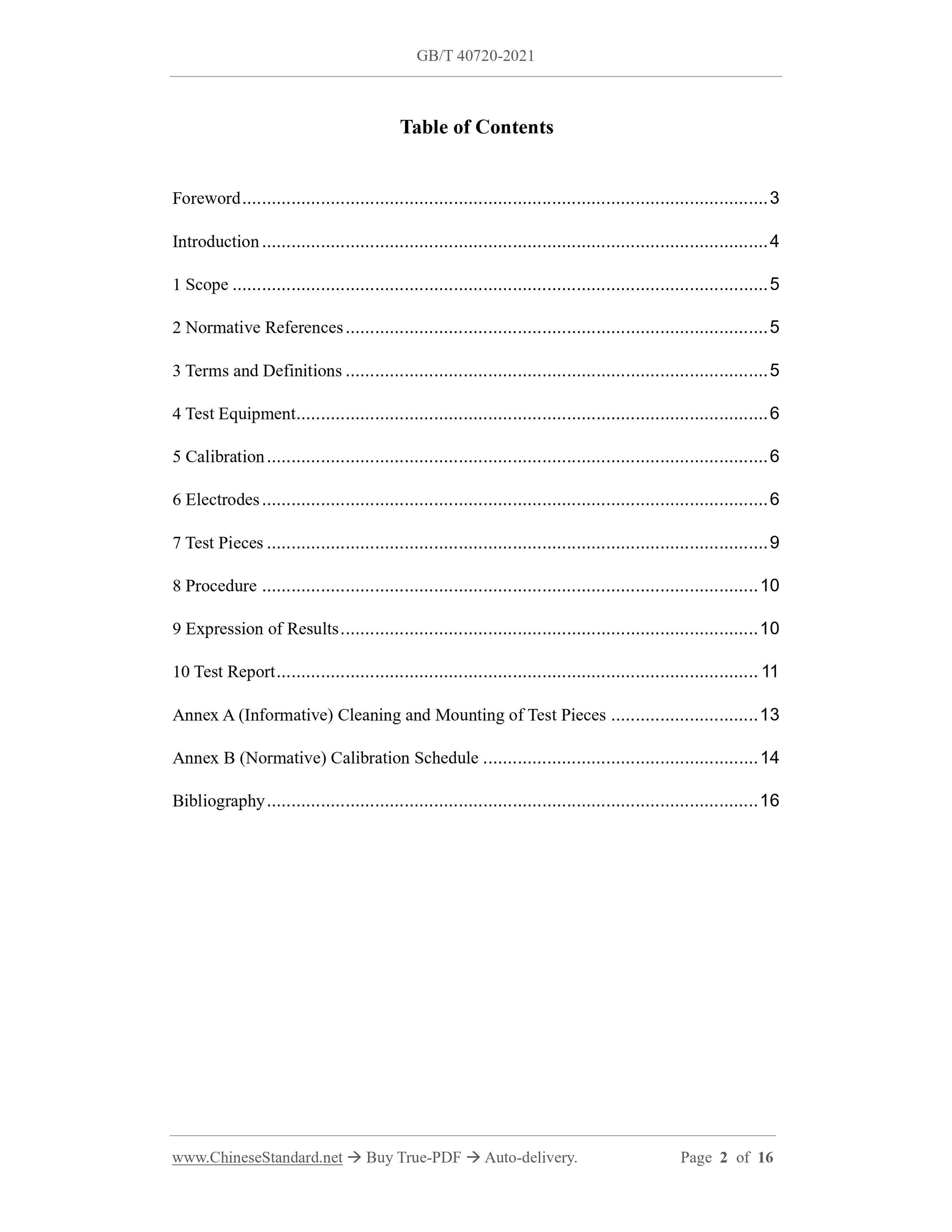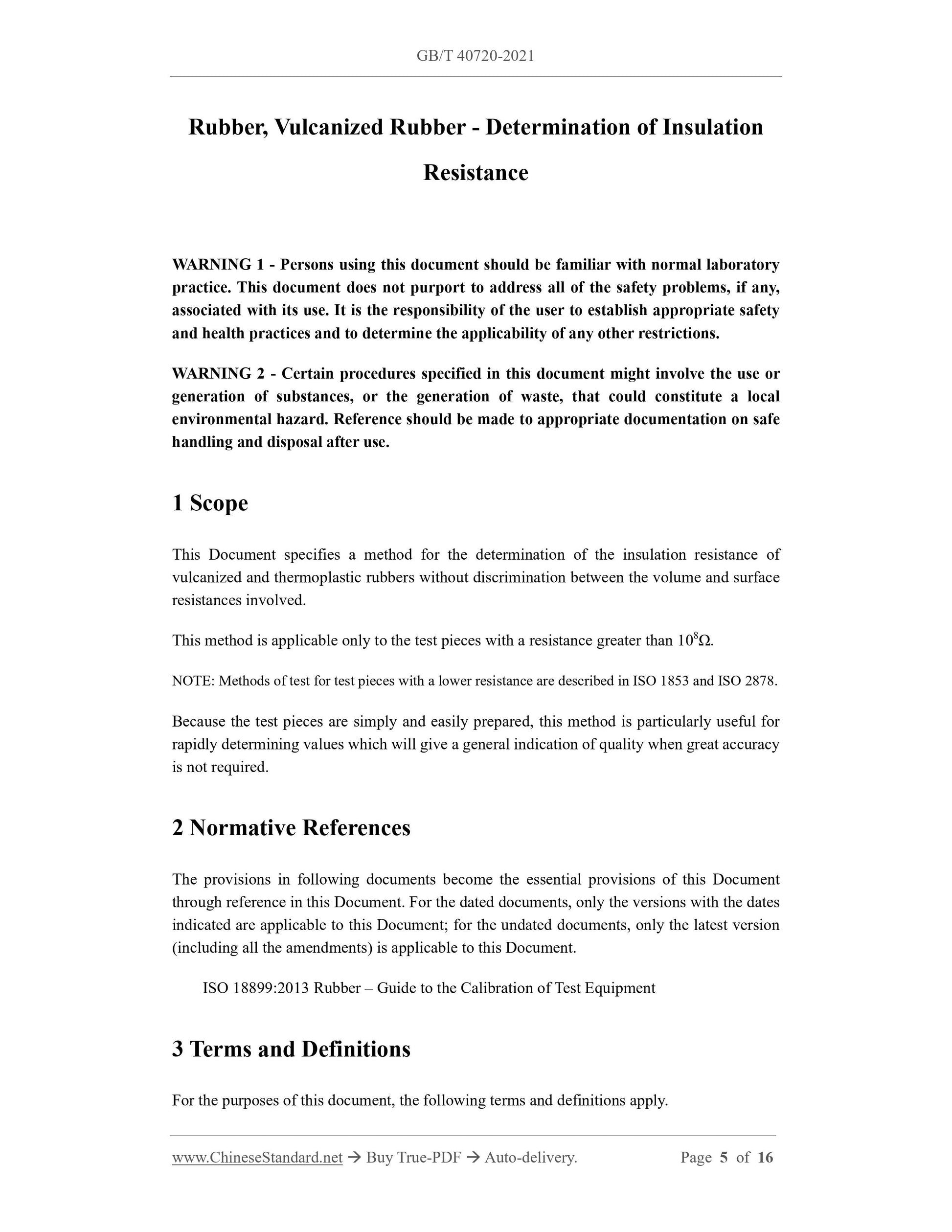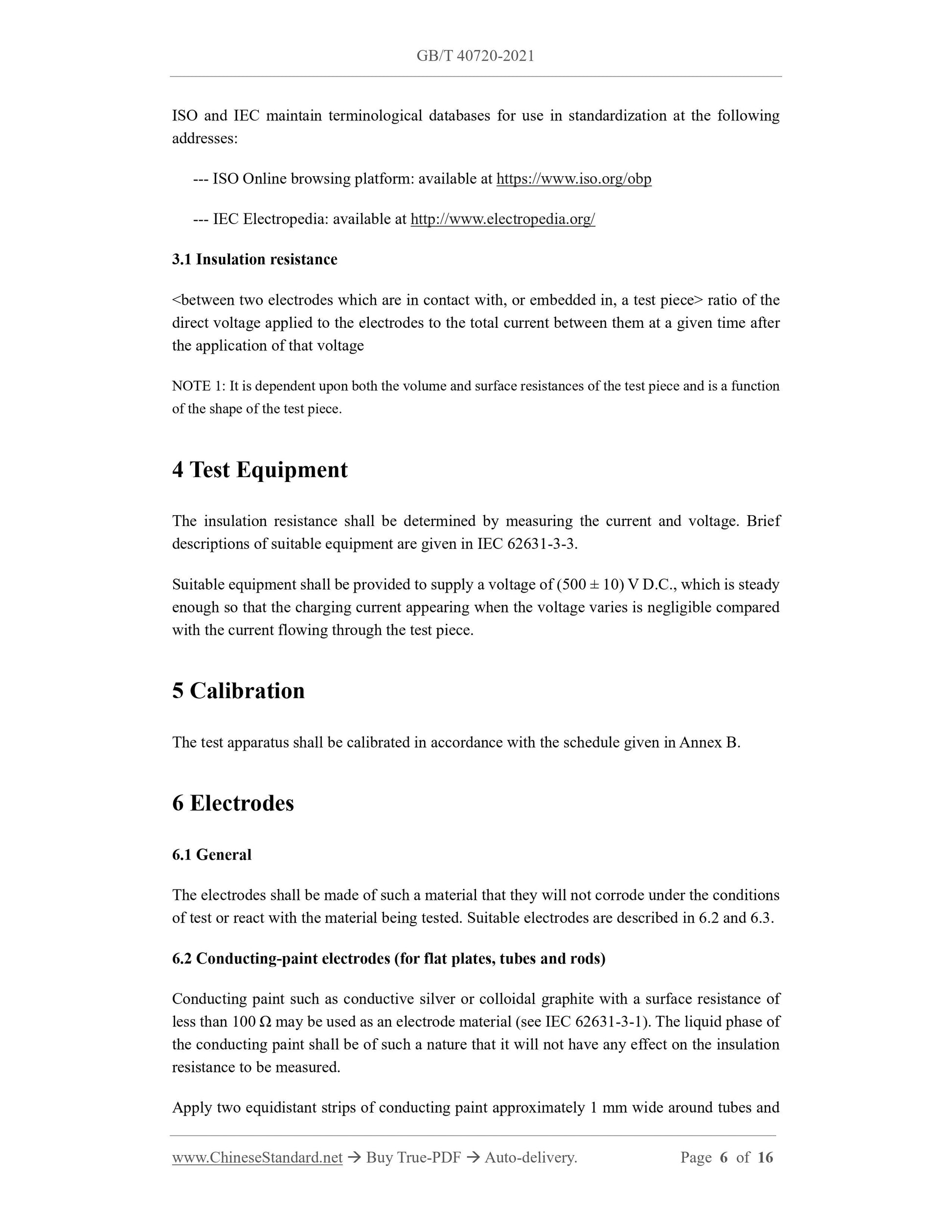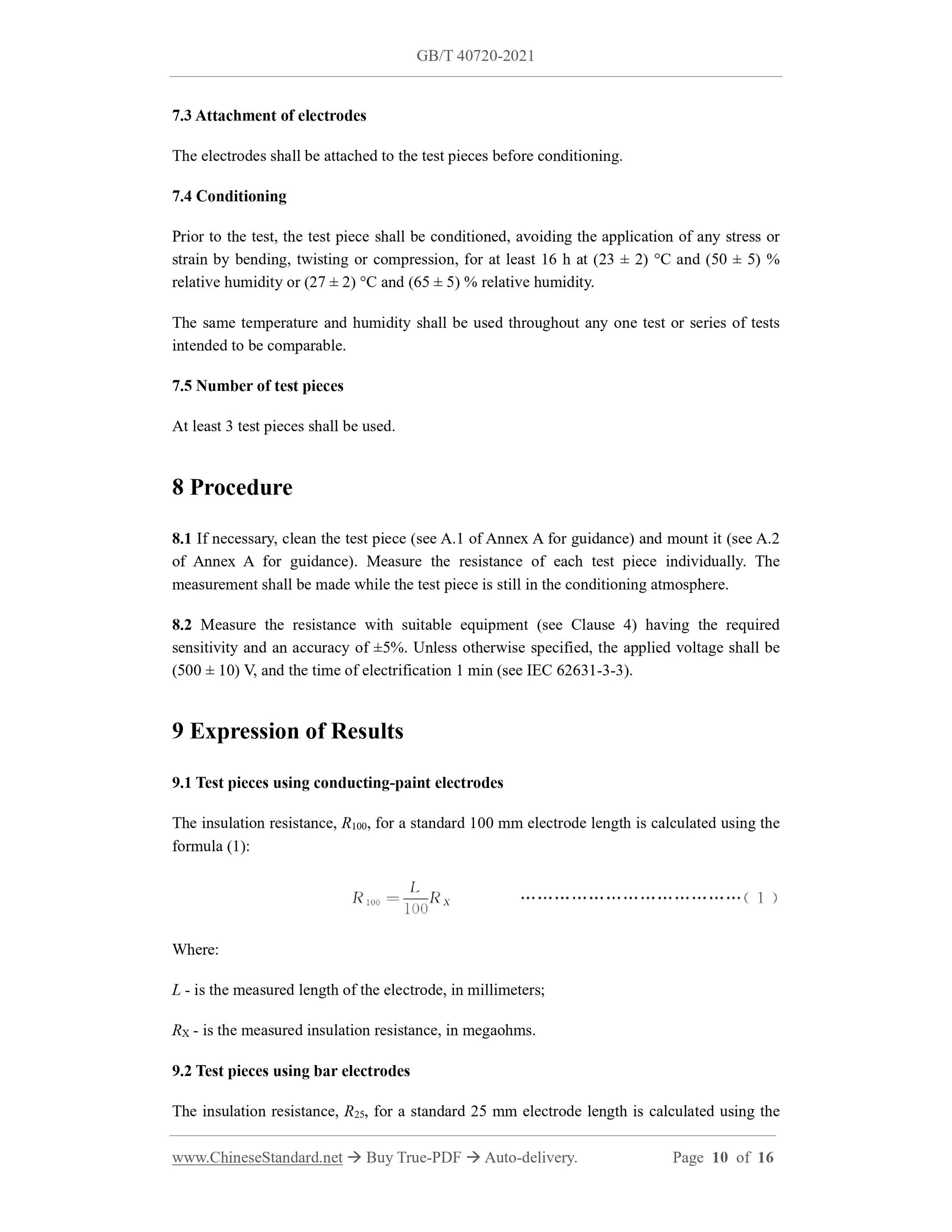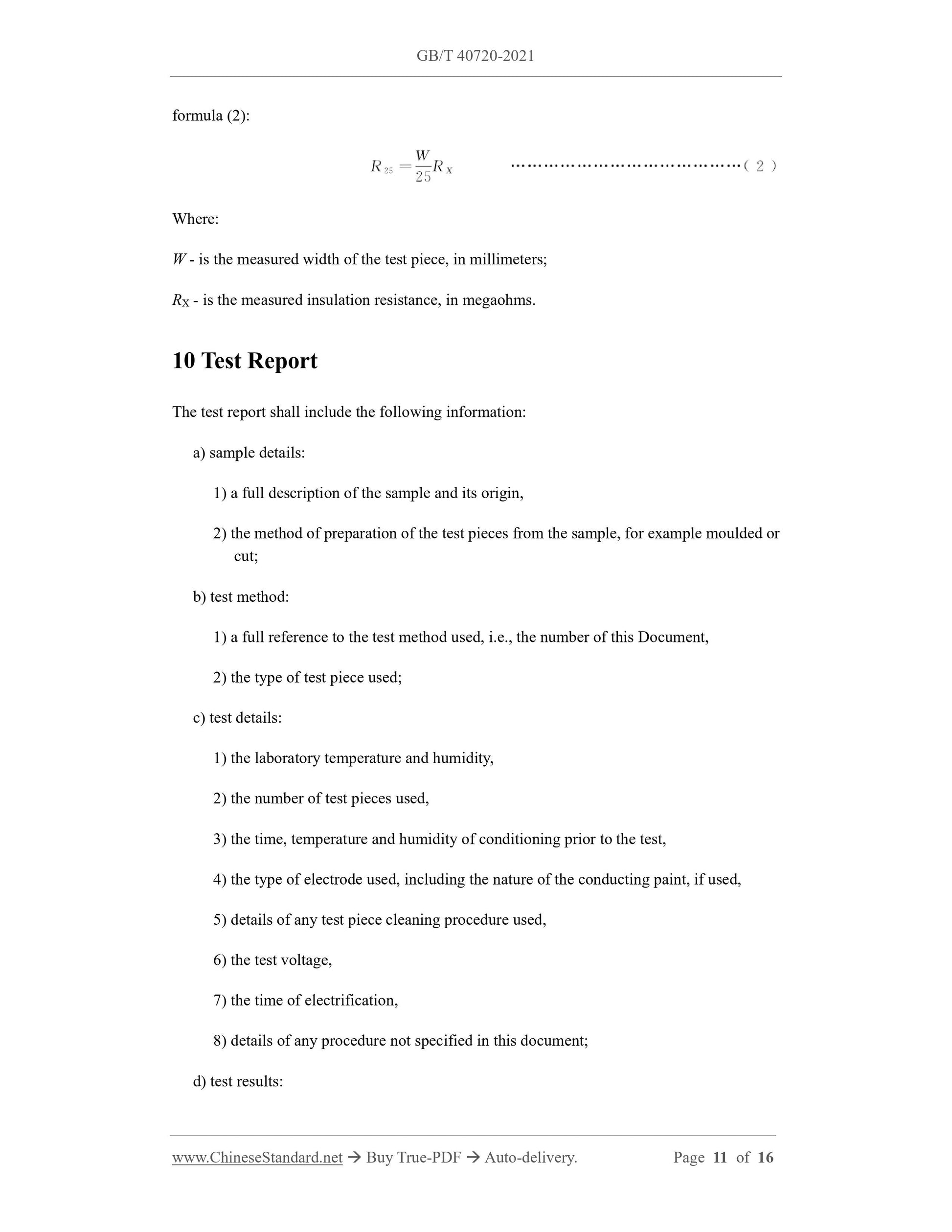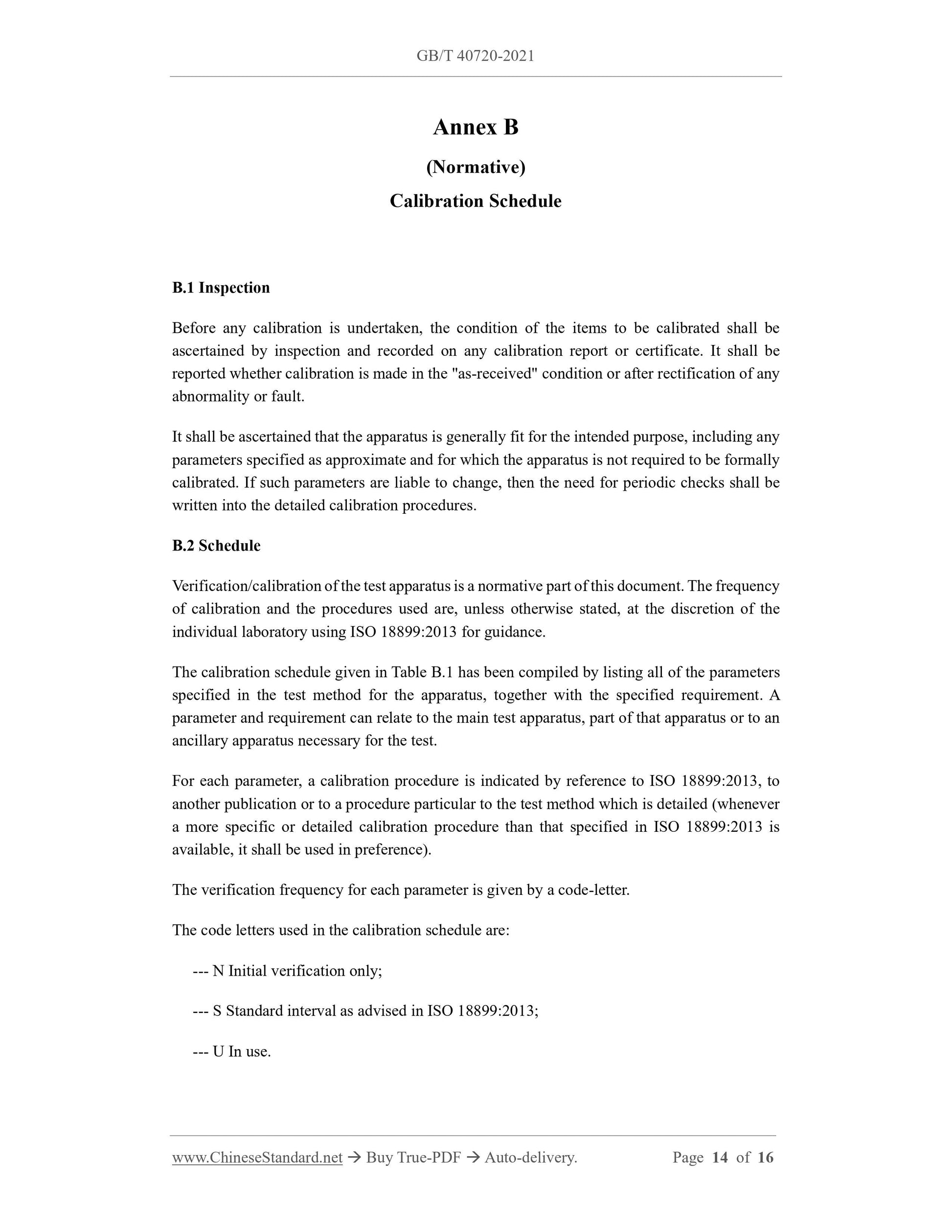1
/
of
7
www.ChineseStandard.us -- Field Test Asia Pte. Ltd.
GB/T 40720-2021 English PDF (GB/T40720-2021)
GB/T 40720-2021 English PDF (GB/T40720-2021)
Regular price
$205.00
Regular price
Sale price
$205.00
Unit price
/
per
Shipping calculated at checkout.
Couldn't load pickup availability
GB/T 40720-2021: Rubber, vulcanized rubber - Determination of insulation resistance
Delivery: 9 seconds. Download (& Email) true-PDF + Invoice.
Get Quotation: Click GB/T 40720-2021 (Self-service in 1-minute)
Historical versions (Master-website): GB/T 40720-2021
Preview True-PDF (Reload/Scroll-down if blank)
GB/T 40720-2021
GB
NATIONAL STANDARD OF THE
PEOPLE’S REPUBLIC OF CHINA
ICS 83.060
CCS G 40
GB/T 40720-2021 / ISO 2951:2019
Rubber, Vulcanized Rubber - Determination of Insulation
Resistance
(ISO 2951:2019, IDT)
ISSUED ON: OCTOBER 11, 2021
IMPLEMENTED ON: MAY 01, 2022
Issued by: State Administration for Market Regulation;
Standardization Administration of the People’s Republic of China.
Table of Contents
Foreword ... 3
Introduction ... 4
1 Scope ... 5
2 Normative References ... 5
3 Terms and Definitions ... 5
4 Test Equipment ... 6
5 Calibration ... 6
6 Electrodes ... 6
7 Test Pieces ... 9
8 Procedure ... 10
9 Expression of Results ... 10
10 Test Report ... 11
Annex A (Informative) Cleaning and Mounting of Test Pieces ... 13
Annex B (Normative) Calibration Schedule ... 14
Bibliography ... 16
Rubber, Vulcanized Rubber - Determination of Insulation
Resistance
WARNING 1 - Persons using this document should be familiar with normal laboratory
practice. This document does not purport to address all of the safety problems, if any,
associated with its use. It is the responsibility of the user to establish appropriate safety
and health practices and to determine the applicability of any other restrictions.
WARNING 2 - Certain procedures specified in this document might involve the use or
generation of substances, or the generation of waste, that could constitute a local
environmental hazard. Reference should be made to appropriate documentation on safe
handling and disposal after use.
1 Scope
This Document specifies a method for the determination of the insulation resistance of
vulcanized and thermoplastic rubbers without discrimination between the volume and surface
resistances involved.
This method is applicable only to the test pieces with a resistance greater than 108Ω.
NOTE: Methods of test for test pieces with a lower resistance are described in ISO 1853 and ISO 2878.
Because the test pieces are simply and easily prepared, this method is particularly useful for
rapidly determining values which will give a general indication of quality when great accuracy
is not required.
2 Normative References
The provisions in following documents become the essential provisions of this Document
through reference in this Document. For the dated documents, only the versions with the dates
indicated are applicable to this Document; for the undated documents, only the latest version
(including all the amendments) is applicable to this Document.
ISO 18899:2013 Rubber – Guide to the Calibration of Test Equipment
3 Terms and Definitions
For the purposes of this document, the following terms and definitions apply.
ISO and IEC maintain terminological databases for use in standardization at the following
addresses:
--- ISO Online browsing platform: available at https://www.iso.org/obp
--- IEC Electropedia: available at http://www.electropedia.org/
3.1 Insulation resistance
< between two electrodes which are in contact with, or embedded in, a test piece> ratio of the
direct voltage applied to the electrodes to the total current between them at a given time after
the application of that voltage
NOTE 1: It is dependent upon both the volume and surface resistances of the test piece and is a function
of the shape of the test piece.
4 Test Equipment
The insulation resistance shall be determined by measuring the current and voltage. Brief
descriptions of suitable equipment are given in IEC 62631-3-3.
Suitable equipment shall be provided to supply a voltage of (500 ± 10) V D.C., which is steady
enough so that the charging current appearing when the voltage varies is negligible compared
with the current flowing through the test piece.
5 Calibration
The test apparatus shall be calibrated in accordance with the schedule given in Annex B.
6 Electrodes
6.1 General
The electrodes shall be made of such a material that they will not corrode under the conditions
of test or react with the material being tested. Suitable electrodes are described in 6.2 and 6.3.
6.2 Conducting-paint electrodes (for flat plates, tubes and rods)
Conducting paint such as conductive silver or colloidal graphite with a surface resistance of
less than 100 Ω may be used as an electrode material (see IEC 62631-3-1). The liquid phase of
the conducting paint shall be of such a nature that it will not have any effect on the insulation
resistance to be measured.
Apply two equidistant strips of conducting paint approximately 1 mm wide around tubes and
7.3 Attachment of electrodes
The electrodes shall be attached to the test pieces before conditioning.
7.4 Conditioning
Prior to the test, the test piece shall be conditioned, avoiding the application of any stress or
strain by bending, twisting or compression, for at least 16 h at (23 ± 2) °C and (50 ± 5) %
relative humidity or (27 ± 2) °C and (65 ± 5) % relative humidity.
The same temperature and humidity shall be used throughout any one test or series of tests
intended to be comparable.
7.5 Number of test pieces
At least 3 test pieces shall be used.
8 Procedure
8.1 If necessary, clean the test piece (see A.1 of Annex A for guidance) and mount it (see A.2
of Annex A for guidance). Measure the resistance of each test piece individually. The
measurement shall be made while the test piece is still in the conditioning atmosphere.
8.2 Measure the resistance with suitable equipment (see Clause 4) having the required
sensitivity and an accuracy of ±5%. Unless otherwise specified, the applied voltage shall be
(500 ± 10) V, and the time of electrification 1 min (see IEC 62631-3-3).
9 Expression of Results
9.1 Test pieces using conducting-paint electrodes
The insulation resistance, R100, for a standard 100 mm electrode length is calculated using the
formula (1):
Where:
L - is the measured length of the electrode, in millimeters;
RX - is the measured insulation resistance, in megaohms.
9.2 Test pieces using bar electrodes
The insulation resistance, R25, for a standard 25 mm electrode length is calculated using the
formula (2):
Where:
W - is the measured width of the test piece, in millimeters;
RX - is the measured insulation resistance, in megaohms.
10 Test Report
The test report shall include the following information:
a) sample details:
1) a full description of the sample and its origin,
2) the method of preparation of the test pieces from the sample, for example moulded or
cut;
b) test method:
1) a full reference to the test method used, i.e., the number of this Document,
2) the type of test piece used;
c) test details:
1) the laboratory temperature and humidity,
2) the number of test pieces used,
3) the time, temperature and humidity of conditioning prior to the test,
4) the type of electrode used, including the nature of the conducting paint, if used,
5) details of any test piece cleaning procedure used,
6) the test voltage,
7) the time of electrification,
8) details of any procedure not specified in this document;
d) test results:
Annex B
(Normative)
Calibration Schedule
B.1 Inspection
Before any calibration is undertaken, the condition of the items to be calibrated shall be
ascertained by inspection and recorded on any calibration report or certificate. It shall be
reported whether calibration is made in the "as-received" condition or after rectification of any
abnormality or fault.
It shall be ascertained that the apparatus is generally fit for the intended purpose, including any
parameters specified as approximate and for which the apparatus is not required to be formally
calibrated. If such parameters are liable to change, then the need for periodic checks shall be
written into the detailed calibration procedures.
B.2 Schedule
Verification/calibration of the test apparatus is a normative part of this document. The frequency
of calibration and the procedures used are, unless otherwise stated, at the discretion of the
individual laboratory using ISO 18899:2013 for guidance.
The calibration schedule given in Table B.1 has been compiled by listing all of the parameters
specified in the test method for the apparatus, together with the specified requirement. A
parameter and requirement can relate to the main test apparatus, part of that apparatus or to an
ancillary apparatus necessary for the test.
For each parameter, a calibration procedure is indicated by reference to ISO 18899:2013, to
another publication or to a procedure particular to the test method which is detailed (whenever
a more specific or detailed calibration procedure than that specified in ISO 18899:2013 is
available, it shall be used in preference).
The verification frequency for each parameter is given by a code-letter.
The code letters used in the calibration schedule are:
--- N Initial verification only;
--- S Standard interval as advised in ISO 18899:2013;
--- U In use.
GB/T 40720-2021
GB
NATIONAL STANDARD OF THE
PEOPLE’S REPUBLIC OF CHINA
ICS 83.060
CCS G 40
GB/T 40720-2021 / ISO 2951:2019
Rubber, Vulcanized Rubber - Determination of Insulation
Resistance
(ISO 2951:2019, IDT)
ISSUED ON: OCTOBER 11, 2021
IMPLEMENTED ON: MAY 01, 2022
Issued by: State Administration for Market Regulation;
Standardization Administration of the People’s Republic of China.
Table of Contents
Foreword ... 3
Introduction ... 4
1 Scope ... 5
2 Normative References ... 5
3 Terms and Definitions ... 5
4 Test Equipment ... 6
5 Calibration ... 6
6 Electrodes ... 6
7 Test Pieces ... 9
8 Procedure ... 10
9 Expression of Results ... 10
10 Test Report ... 11
Annex A (Informative) Cleaning and Mounting of Test Pieces ... 13
Annex B (Normative) Calibration Schedule ... 14
Bibliography ... 16
Rubber, Vulcanized Rubber - Determination of Insulation
Resistance
WARNING 1 - Persons using this document should be familiar with normal laboratory
practice. This document does not purport to address all of the safety problems, if any,
associated with its use. It is the responsibility of the user to establish appropriate safety
and health practices and to determine the applicability of any other restrictions.
WARNING 2 - Certain procedures specified in this document might involve the use or
generation of substances, or the generation of waste, that could constitute a local
environmental hazard. Reference should be made to appropriate documentation on safe
handling and disposal after use.
1 Scope
This Document specifies a method for the determination of the insulation resistance of
vulcanized and thermoplastic rubbers without discrimination between the volume and surface
resistances involved.
This method is applicable only to the test pieces with a resistance greater than 108Ω.
NOTE: Methods of test for test pieces with a lower resistance are described in ISO 1853 and ISO 2878.
Because the test pieces are simply and easily prepared, this method is particularly useful for
rapidly determining values which will give a general indication of quality when great accuracy
is not required.
2 Normative References
The provisions in following documents become the essential provisions of this Document
through reference in this Document. For the dated documents, only the versions with the dates
indicated are applicable to this Document; for the undated documents, only the latest version
(including all the amendments) is applicable to this Document.
ISO 18899:2013 Rubber – Guide to the Calibration of Test Equipment
3 Terms and Definitions
For the purposes of this document, the following terms and definitions apply.
ISO and IEC maintain terminological databases for use in standardization at the following
addresses:
--- ISO Online browsing platform: available at https://www.iso.org/obp
--- IEC Electropedia: available at http://www.electropedia.org/
3.1 Insulation resistance
< between two electrodes which are in contact with, or embedded in, a test piece> ratio of the
direct voltage applied to the electrodes to the total current between them at a given time after
the application of that voltage
NOTE 1: It is dependent upon both the volume and surface resistances of the test piece and is a function
of the shape of the test piece.
4 Test Equipment
The insulation resistance shall be determined by measuring the current and voltage. Brief
descriptions of suitable equipment are given in IEC 62631-3-3.
Suitable equipment shall be provided to supply a voltage of (500 ± 10) V D.C., which is steady
enough so that the charging current appearing when the voltage varies is negligible compared
with the current flowing through the test piece.
5 Calibration
The test apparatus shall be calibrated in accordance with the schedule given in Annex B.
6 Electrodes
6.1 General
The electrodes shall be made of such a material that they will not corrode under the conditions
of test or react with the material being tested. Suitable electrodes are described in 6.2 and 6.3.
6.2 Conducting-paint electrodes (for flat plates, tubes and rods)
Conducting paint such as conductive silver or colloidal graphite with a surface resistance of
less than 100 Ω may be used as an electrode material (see IEC 62631-3-1). The liquid phase of
the conducting paint shall be of such a nature that it will not have any effect on the insulation
resistance to be measured.
Apply two equidistant strips of conducting paint approximately 1 mm wide around tubes and
7.3 Attachment of electrodes
The electrodes shall be attached to the test pieces before conditioning.
7.4 Conditioning
Prior to the test, the test piece shall be conditioned, avoiding the application of any stress or
strain by bending, twisting or compression, for at least 16 h at (23 ± 2) °C and (50 ± 5) %
relative humidity or (27 ± 2) °C and (65 ± 5) % relative humidity.
The same temperature and humidity shall be used throughout any one test or series of tests
intended to be comparable.
...
Delivery: 9 seconds. Download (& Email) true-PDF + Invoice.
Get Quotation: Click GB/T 40720-2021 (Self-service in 1-minute)
Historical versions (Master-website): GB/T 40720-2021
Preview True-PDF (Reload/Scroll-down if blank)
GB/T 40720-2021
GB
NATIONAL STANDARD OF THE
PEOPLE’S REPUBLIC OF CHINA
ICS 83.060
CCS G 40
GB/T 40720-2021 / ISO 2951:2019
Rubber, Vulcanized Rubber - Determination of Insulation
Resistance
(ISO 2951:2019, IDT)
ISSUED ON: OCTOBER 11, 2021
IMPLEMENTED ON: MAY 01, 2022
Issued by: State Administration for Market Regulation;
Standardization Administration of the People’s Republic of China.
Table of Contents
Foreword ... 3
Introduction ... 4
1 Scope ... 5
2 Normative References ... 5
3 Terms and Definitions ... 5
4 Test Equipment ... 6
5 Calibration ... 6
6 Electrodes ... 6
7 Test Pieces ... 9
8 Procedure ... 10
9 Expression of Results ... 10
10 Test Report ... 11
Annex A (Informative) Cleaning and Mounting of Test Pieces ... 13
Annex B (Normative) Calibration Schedule ... 14
Bibliography ... 16
Rubber, Vulcanized Rubber - Determination of Insulation
Resistance
WARNING 1 - Persons using this document should be familiar with normal laboratory
practice. This document does not purport to address all of the safety problems, if any,
associated with its use. It is the responsibility of the user to establish appropriate safety
and health practices and to determine the applicability of any other restrictions.
WARNING 2 - Certain procedures specified in this document might involve the use or
generation of substances, or the generation of waste, that could constitute a local
environmental hazard. Reference should be made to appropriate documentation on safe
handling and disposal after use.
1 Scope
This Document specifies a method for the determination of the insulation resistance of
vulcanized and thermoplastic rubbers without discrimination between the volume and surface
resistances involved.
This method is applicable only to the test pieces with a resistance greater than 108Ω.
NOTE: Methods of test for test pieces with a lower resistance are described in ISO 1853 and ISO 2878.
Because the test pieces are simply and easily prepared, this method is particularly useful for
rapidly determining values which will give a general indication of quality when great accuracy
is not required.
2 Normative References
The provisions in following documents become the essential provisions of this Document
through reference in this Document. For the dated documents, only the versions with the dates
indicated are applicable to this Document; for the undated documents, only the latest version
(including all the amendments) is applicable to this Document.
ISO 18899:2013 Rubber – Guide to the Calibration of Test Equipment
3 Terms and Definitions
For the purposes of this document, the following terms and definitions apply.
ISO and IEC maintain terminological databases for use in standardization at the following
addresses:
--- ISO Online browsing platform: available at https://www.iso.org/obp
--- IEC Electropedia: available at http://www.electropedia.org/
3.1 Insulation resistance
< between two electrodes which are in contact with, or embedded in, a test piece> ratio of the
direct voltage applied to the electrodes to the total current between them at a given time after
the application of that voltage
NOTE 1: It is dependent upon both the volume and surface resistances of the test piece and is a function
of the shape of the test piece.
4 Test Equipment
The insulation resistance shall be determined by measuring the current and voltage. Brief
descriptions of suitable equipment are given in IEC 62631-3-3.
Suitable equipment shall be provided to supply a voltage of (500 ± 10) V D.C., which is steady
enough so that the charging current appearing when the voltage varies is negligible compared
with the current flowing through the test piece.
5 Calibration
The test apparatus shall be calibrated in accordance with the schedule given in Annex B.
6 Electrodes
6.1 General
The electrodes shall be made of such a material that they will not corrode under the conditions
of test or react with the material being tested. Suitable electrodes are described in 6.2 and 6.3.
6.2 Conducting-paint electrodes (for flat plates, tubes and rods)
Conducting paint such as conductive silver or colloidal graphite with a surface resistance of
less than 100 Ω may be used as an electrode material (see IEC 62631-3-1). The liquid phase of
the conducting paint shall be of such a nature that it will not have any effect on the insulation
resistance to be measured.
Apply two equidistant strips of conducting paint approximately 1 mm wide around tubes and
7.3 Attachment of electrodes
The electrodes shall be attached to the test pieces before conditioning.
7.4 Conditioning
Prior to the test, the test piece shall be conditioned, avoiding the application of any stress or
strain by bending, twisting or compression, for at least 16 h at (23 ± 2) °C and (50 ± 5) %
relative humidity or (27 ± 2) °C and (65 ± 5) % relative humidity.
The same temperature and humidity shall be used throughout any one test or series of tests
intended to be comparable.
7.5 Number of test pieces
At least 3 test pieces shall be used.
8 Procedure
8.1 If necessary, clean the test piece (see A.1 of Annex A for guidance) and mount it (see A.2
of Annex A for guidance). Measure the resistance of each test piece individually. The
measurement shall be made while the test piece is still in the conditioning atmosphere.
8.2 Measure the resistance with suitable equipment (see Clause 4) having the required
sensitivity and an accuracy of ±5%. Unless otherwise specified, the applied voltage shall be
(500 ± 10) V, and the time of electrification 1 min (see IEC 62631-3-3).
9 Expression of Results
9.1 Test pieces using conducting-paint electrodes
The insulation resistance, R100, for a standard 100 mm electrode length is calculated using the
formula (1):
Where:
L - is the measured length of the electrode, in millimeters;
RX - is the measured insulation resistance, in megaohms.
9.2 Test pieces using bar electrodes
The insulation resistance, R25, for a standard 25 mm electrode length is calculated using the
formula (2):
Where:
W - is the measured width of the test piece, in millimeters;
RX - is the measured insulation resistance, in megaohms.
10 Test Report
The test report shall include the following information:
a) sample details:
1) a full description of the sample and its origin,
2) the method of preparation of the test pieces from the sample, for example moulded or
cut;
b) test method:
1) a full reference to the test method used, i.e., the number of this Document,
2) the type of test piece used;
c) test details:
1) the laboratory temperature and humidity,
2) the number of test pieces used,
3) the time, temperature and humidity of conditioning prior to the test,
4) the type of electrode used, including the nature of the conducting paint, if used,
5) details of any test piece cleaning procedure used,
6) the test voltage,
7) the time of electrification,
8) details of any procedure not specified in this document;
d) test results:
Annex B
(Normative)
Calibration Schedule
B.1 Inspection
Before any calibration is undertaken, the condition of the items to be calibrated shall be
ascertained by inspection and recorded on any calibration report or certificate. It shall be
reported whether calibration is made in the "as-received" condition or after rectification of any
abnormality or fault.
It shall be ascertained that the apparatus is generally fit for the intended purpose, including any
parameters specified as approximate and for which the apparatus is not required to be formally
calibrated. If such parameters are liable to change, then the need for periodic checks shall be
written into the detailed calibration procedures.
B.2 Schedule
Verification/calibration of the test apparatus is a normative part of this document. The frequency
of calibration and the procedures used are, unless otherwise stated, at the discretion of the
individual laboratory using ISO 18899:2013 for guidance.
The calibration schedule given in Table B.1 has been compiled by listing all of the parameters
specified in the test method for the apparatus, together with the specified requirement. A
parameter and requirement can relate to the main test apparatus, part of that apparatus or to an
ancillary apparatus necessary for the test.
For each parameter, a calibration procedure is indicated by reference to ISO 18899:2013, to
another publication or to a procedure particular to the test method which is detailed (whenever
a more specific or detailed calibration procedure than that specified in ISO 18899:2013 is
available, it shall be used in preference).
The verification frequency for each parameter is given by a code-letter.
The code letters used in the calibration schedule are:
--- N Initial verification only;
--- S Standard interval as advised in ISO 18899:2013;
--- U In use.
GB/T 40720-2021
GB
NATIONAL STANDARD OF THE
PEOPLE’S REPUBLIC OF CHINA
ICS 83.060
CCS G 40
GB/T 40720-2021 / ISO 2951:2019
Rubber, Vulcanized Rubber - Determination of Insulation
Resistance
(ISO 2951:2019, IDT)
ISSUED ON: OCTOBER 11, 2021
IMPLEMENTED ON: MAY 01, 2022
Issued by: State Administration for Market Regulation;
Standardization Administration of the People’s Republic of China.
Table of Contents
Foreword ... 3
Introduction ... 4
1 Scope ... 5
2 Normative References ... 5
3 Terms and Definitions ... 5
4 Test Equipment ... 6
5 Calibration ... 6
6 Electrodes ... 6
7 Test Pieces ... 9
8 Procedure ... 10
9 Expression of Results ... 10
10 Test Report ... 11
Annex A (Informative) Cleaning and Mounting of Test Pieces ... 13
Annex B (Normative) Calibration Schedule ... 14
Bibliography ... 16
Rubber, Vulcanized Rubber - Determination of Insulation
Resistance
WARNING 1 - Persons using this document should be familiar with normal laboratory
practice. This document does not purport to address all of the safety problems, if any,
associated with its use. It is the responsibility of the user to establish appropriate safety
and health practices and to determine the applicability of any other restrictions.
WARNING 2 - Certain procedures specified in this document might involve the use or
generation of substances, or the generation of waste, that could constitute a local
environmental hazard. Reference should be made to appropriate documentation on safe
handling and disposal after use.
1 Scope
This Document specifies a method for the determination of the insulation resistance of
vulcanized and thermoplastic rubbers without discrimination between the volume and surface
resistances involved.
This method is applicable only to the test pieces with a resistance greater than 108Ω.
NOTE: Methods of test for test pieces with a lower resistance are described in ISO 1853 and ISO 2878.
Because the test pieces are simply and easily prepared, this method is particularly useful for
rapidly determining values which will give a general indication of quality when great accuracy
is not required.
2 Normative References
The provisions in following documents become the essential provisions of this Document
through reference in this Document. For the dated documents, only the versions with the dates
indicated are applicable to this Document; for the undated documents, only the latest version
(including all the amendments) is applicable to this Document.
ISO 18899:2013 Rubber – Guide to the Calibration of Test Equipment
3 Terms and Definitions
For the purposes of this document, the following terms and definitions apply.
ISO and IEC maintain terminological databases for use in standardization at the following
addresses:
--- ISO Online browsing platform: available at https://www.iso.org/obp
--- IEC Electropedia: available at http://www.electropedia.org/
3.1 Insulation resistance
< between two electrodes which are in contact with, or embedded in, a test piece> ratio of the
direct voltage applied to the electrodes to the total current between them at a given time after
the application of that voltage
NOTE 1: It is dependent upon both the volume and surface resistances of the test piece and is a function
of the shape of the test piece.
4 Test Equipment
The insulation resistance shall be determined by measuring the current and voltage. Brief
descriptions of suitable equipment are given in IEC 62631-3-3.
Suitable equipment shall be provided to supply a voltage of (500 ± 10) V D.C., which is steady
enough so that the charging current appearing when the voltage varies is negligible compared
with the current flowing through the test piece.
5 Calibration
The test apparatus shall be calibrated in accordance with the schedule given in Annex B.
6 Electrodes
6.1 General
The electrodes shall be made of such a material that they will not corrode under the conditions
of test or react with the material being tested. Suitable electrodes are described in 6.2 and 6.3.
6.2 Conducting-paint electrodes (for flat plates, tubes and rods)
Conducting paint such as conductive silver or colloidal graphite with a surface resistance of
less than 100 Ω may be used as an electrode material (see IEC 62631-3-1). The liquid phase of
the conducting paint shall be of such a nature that it will not have any effect on the insulation
resistance to be measured.
Apply two equidistant strips of conducting paint approximately 1 mm wide around tubes and
7.3 Attachment of electrodes
The electrodes shall be attached to the test pieces before conditioning.
7.4 Conditioning
Prior to the test, the test piece shall be conditioned, avoiding the application of any stress or
strain by bending, twisting or compression, for at least 16 h at (23 ± 2) °C and (50 ± 5) %
relative humidity or (27 ± 2) °C and (65 ± 5) % relative humidity.
The same temperature and humidity shall be used throughout any one test or series of tests
intended to be comparable.
...
Share
